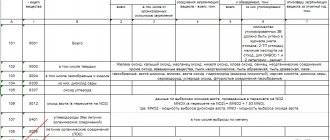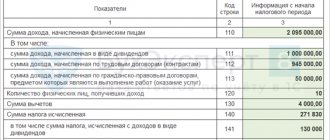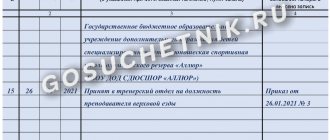Business lawyer > Accounting > Accounting and reporting > Line 2350 of the Financial Results Report: essence and rules for filling out
One of the most important indicators for assessing the performance of a business is its costs. They have a direct impact on the results of the work. In addition to production costs and commercial expenses, the Financial Results Report contains a separate line for expenses called “other”. The procedure for their calculation and inclusion in a financial document is regulated by accounting legislation.
General provisions about the Report
The financial results statement is one of the fundamental final accounting documents. Until 2013, it bore a name that reflected only the final indicator of business activity: profit or loss. Now it is clear from it that the content of the reporting document includes, in addition to the level of profit achieved or loss incurred, other indicators.
Financial statements
Based on the information presented in the final financial statements, an assessment is made of the financial and economic position of the company, the level of its profitability and liquidity, and operational stability. It is necessary to predict the future performance of a business, therefore it is used by almost all counterparties: government agencies, banking institutions, partners, investors.
The form for drawing up a financial report was approved by the Ministry of Finance by order No. 66 n of 2010 and is presented in the first appendix to it under the previously existing name “Profit and Loss Statement”. Information from this document supplements the information included in the main body of the company - the balance sheet.
If the balance sheet shows that a business entity has active funds and liabilities at the end of the reporting year, then from the report you can find out about the amount of income it has achieved over the past period of time and the expenses it has incurred in the course of business, the receipt of net profit or loss, i.e. about business performance over the past year.
Conventionally, the structure of the report under consideration is represented by four large sections:
- Company income and costs by main types of business activity.
- Amounts of income and expenses that differ from the main expenses and benefits - other.
- The financial result of doing business for the past annual period.
- Reference information.
The report is compiled for the entire enterprise, regardless of the tax regime used, under which it operates and whether it has independent structural divisions.
Annual data
In addition to the indicators of the reporting year, for example, for 2022, the document provides information for the same previous period, i.e. for 2016. As follows from the rule established by clause 10 of PBU 4/99, if the information for two adjacent years turns out to be incomparable, it must be brought to a comparable form by adjusting it.
PBU 9/99, dedicated to the profitability of companies, PBU 10/99, regulating expenses, classify all income and expenses of business entities into two groups:
- from normal (main) activities
- other
Each organization itself decides the issue of assigning certain costs to the first or second group, reflecting the accepted principles of separation in its internal accounting policy. This right is clarified by the Ministry of Finance in letter No. 07-02-06/203.
What company costs are included in other expenses?
Expenses classified by the company as other are shown in the report under consideration on line 2350. Interest payable should be excluded from them.
Other costs include:
- costs incurred as a result of the company's participation in the charter of third-party business entities
- expenses caused by the write-off or sale of manufactured products, goods, fixed assets
- interest paid by an enterprise on credit and other similar obligations
- service costs in organizations lending business
- debt of counterparties with an expired statute of limitations
- expenses for issuing property for rent, including objects related to the company’s intellectual property
Expense items - allocations to reserve funds, which are formed in accordance with accounting rules (for depreciation of investments in the Central Bank, for problematic debt, etc.)
- allocations to own reserves, organized in cases of recognition of conditional facts of business affairs
- penalties, compensation, penalties, fines for violations of contractual discipline
- compensation for losses of other persons resulting from the actions of the company
- last year's losses recognized in the current period
- other debts that are not possible to collect
- difference in payment amounts or revenue resulting from changes in exchange rates
- markdown of owned resources
- donations to charity
- expenses for organizing cultural, entertainment, sports and other similar events
- expenses resulting from force majeure in business activities
Definition
Other expenses 2350 are other expenses of the organization that are not expenses for core activities, that is, cost of sales:
- expenses associated with the provision for a fee for temporary use (temporary possession and use) of the organization’s assets (if this is not the main subject of activity);
- expenses associated with the provision for a fee of rights arising from patents for inventions, industrial designs and other types of intellectual property (if this is not the main subject of activity);
- expenses associated with participation in the authorized capitals of other organizations (if this is not the main subject of activity);
- expenses associated with the sale, disposal and other write-off of fixed assets and other assets other than cash (except foreign currency), goods, products;
- interest paid by an organization for providing it with funds (credits, borrowings) for use;
- expenses related to payment for services provided by credit institutions;
- contributions to valuation reserves created in accordance with accounting rules (reserves for doubtful debts, for depreciation of investments in securities, etc.), as well as reserves created in connection with the recognition of contingent facts of economic activity;
- fines, penalties, penalties for violation of contract terms;
- compensation for losses caused by the organization;
- losses of previous years recognized in the reporting year;
- amounts of receivables for which the statute of limitations has expired, and other debts that are unrealistic for collection;
- exchange differences;
- the amount of asset depreciation;
- transfer of funds (contributions, payments, etc.) related to charitable activities, expenses for sporting events, recreation, entertainment, cultural and educational events and other similar events;
- other expenses;
- expenses arising as a consequence of emergency circumstances of economic activity (natural disaster, fire, accident, nationalization of property, etc.).
In anfin.ru services, the value of this indicator is entered into the cells without the minus sign.
Information used to fill out line "2350"?
The information base for line 2350 of the financial document under consideration is the final turnover indicator. In this case, the following are not taken into account:
- accounts on which interest is payable
- value added tax invoices
- excise taxes
- other similar obligatory financial resources that the company receives from contractors and citizens
Data Search
The indicator for Dt 91-2 corresponds with the credit of various accounts: account. 01, count. 02, count. 10, count. 50, count. 52, count. 60, count. 62, count. 76.
In the financial report it is allowed not to make a detailed reflection of other expenses:
- If the accounting rules provide for or do not prohibit their reflection in this form.
- If the company’s income and the costs associated with them arose from one identical fact of entrepreneurial actions and are not particularly significant in the final parameter of the financial condition of the enterprise.
Accounting entries
The principles for drawing up accounting entries are regulated by the Chart of Accounts (Order of the Ministry of Finance of the Russian Federation No. 94n dated October 30, 2000). Accounting for non-core costs is carried out on active-passive account 91 “Other income and expenses”. The amounts of income and expenses are accounted for separately in subaccounts:
- 91.1 – other income;
- 91.2 – other expenses;
- 91.9 – balance of other expenses and income.
Mom, why did you study to be an accountant? Since childhood, I have not liked numbers. Source: freepik.com/rastudio
At the end of the month, debit and credit turnovers are calculated.
The balance is recorded in subaccount 91.9 and at the end of the year is transferred to account 99 “Profits and losses”. The values in subaccount 91.2 correspond with different accounts depending on the business transaction: account. , count , count 10, count. 50, count. 52, count. , count 76. Table. Examples of postings for subaccount 91.2
| Content | Debit | Credit | Amount to be accounted for | Date of entry into accounting |
| Costs under the leasing agreement | 91.2 | 20, 23, 29 | Actual amounts | date of payment |
| The residual value from the disposal of fixed assets and intangible assets was written off | 91.2 | 01, 04 | Residual value | Disposal date |
| Overdue accounts receivable written off | 91.2 | 60, 62, 76 | Accounting amount | Date of expiration of the limitation period, court decision |
| Commission charged for banking services | 91.2 | 76 | Actual amount | Date of payments made |
| Interest accrued on loans received | 91.2 | 76, 66, 67 | Amount according to the agreement | At the end of the month |
| Payments of fines | 91.2 | 60, 62, 76 | Amount by court decision | Date of conviction or court decision |
| Transfers to charity and cultural and sports events | 91.2 | 76 | Actual transfer amount | Date of provision of funds |
Analytical accounting for each business transaction should be kept separately in order to see the full picture of each transaction.
Line 2350: examples of data entry
The indicator entered in line 2350 of the report under consideration is the sum of other company expenses without the total value of line 2330. For clarity, the formula for its calculation can be as follows:
Page 2350 = TO count. 91/2 – page 2330,
where DO count. 91/2 – the amount of annual turnover in the debit of subaccount 91-2.
Attention! When preparing a simplified reporting document, nothing is deducted from the total amount of the company's other expenses.
Let's look at a practical example of the calculation procedure and rules for filling out line 2350.
First option: the company shows the amounts in detail.
In this case, the volume of other expenses is simply equal to the final debit to subaccount 91-2:
Page 2350 = TO count. 91/2
This excludes excise taxes, VAT, interest payable and similar payments that the company receives from third-party business entities and citizens, reflected in account 91-2.
Second method: collapsed presentation of indicators.
Page 2350 = TO count. 91/2 for unbalanced other costs + (KO account 91/1 - DO 91/2) for balanced income and spent funds,
where KO count. 91/1 – total turnover according to Kt 91-1.
For example:
TO count. 91-2 equals 9870 thousand rubles.
KO account 91/1 is 7890 thousand rubles.
Then page 2350 = 9870 + (7890 – 9870) = 9870 – 1980 = 7890
The amount of costs related to other expenses of the organization is entered in parentheses (round brackets) in the document on the company's performance results. So, the result from the above example should be reflected in line 2350 in the following form: (7890).
So, in the course of business activities, in addition to the main costs, firms incur costs called other. Due to the fact that their number constitutes a significant share of the total expenses, the legislation distinguishes them into a separate group and requires them to be included in a special line of the annual financial report with code “2350”. The legislator provided business entities with freedom to classify their own expenses and consolidate it in their accounting policies.
Filling out line 2350 is based on the resulting accounting data, namely the final debit of subaccount 91-2 in correspondence with various accounts. The calculation of the amount depends on the option chosen by the company for reflecting the result: collapsed or expanded. The total value is indicated in the reporting document enclosed in parentheses.
Top
Write your question in the form below








